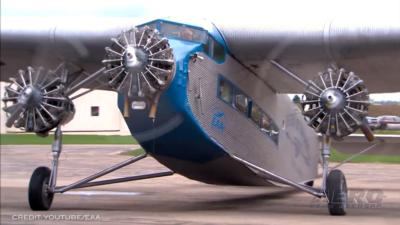Radial Mills to Power EAA’s Ford Tri-Motor
Founded in 1972 and specializing in the repair and overhaul of Pratt & Whitney PT6A turbine, and R-985 and R-1340 radial-engines, Okmulgee, Oklahoma’s Covington Aircraft recently celebrated its fiftieth year in business.

Foremost on the company’s website’s home-page is a message reading: “While the rest of the world seems intent on growth through mergers, Covington Aircraft Engines remains true to the power of one: you. We are one family. Servicing engines from one manufacturer. With one guiding commitment. And by providing uncompromising service with core values first established by the Abbott family, we’ve built Covington Aircraft Engines over the last fifty-years, one customer—and one engine—at a time.”
In keeping with the ethea of service and integrity set forth in the antecedent statement, Covington Aircraft Engines has graciously donated a trio of new R-985 Wasp Junior nine-cylinder 450-horsepower, supercharged air-cooled engines to the Experimental Aircraft Association (EAA). Subject powerplants will be mated to the EAA’s storied and beloved Ford Tri-Motor 4-AT-E.
The first engine was delivered in mid-July, with the remaining engines slated to arrive at the end of 2023 and in early spring 2024 respectively.
Speaking at an unveiling held at EAA’s Kermit Weeks Hangar on Wednesday, 26 July, Covington Aircraft president Aaron Abbott stated: “We love our partnership with EAA. We love EAA and AirVenture. We love coming up here; my wife and kids come up here; my parents are up here. It’s just a great time to come see friends—it’s like a family reunion every summer.”
Abbott’s father, Paul, who founded Covington, joined his wife, Betty; Aaron’s wife, Michelle; and junior Abbotts’ children Emma, Audrey, and son, Oaks, at the Weeks Hangar to celebrate the occasion.
EAA manager of aircraft maintenance John Hopkins remarked: “We’re just so excited to be part of the Covington family, and putting their engines on our airplane will give us many years of reliable service.”
EAA business development manager Andrew Ramsey asserted: “Our relationship with Covington Aircraft is amazing! They sponsor our Wednesday night air show and are also the main sponsor of our Runway 5K. They support EAA in a lot of different ways and are great partners and really good people!”
Designed by William Bushnell Stout and developed by the Ford Motor Company, the Ford Trimotor—colloquially, the Tin Goose—is a three-engined transport aircraft broadly regarded as the world’s first luxury airliner.
Fittingly, the model’s June 1926 introduction occasioned the beginning of commercial air-service.
During its 1925 through 1933 production run, Ford produced 199 specimens of the Trimotor in 42 different iterations for both civilian and military customers.

While seeking backers for his eponymous Stout Metal Aircraft Company, W.B. Stout, a bold and imaginative promotor, sent a mimeographed form letter pluckily requesting $1,000 investments to no fewer than 19 monied individuals—including Henry Ford and his son, Edsel. In the letter, Stout candidly set forth: “"For your one-thousand-dollars, you will get one definite promise: You will never get your money back."
Stout raised $20,000—a kingly sum in the early 1920s.
In 1925, Ford purchased the Stout Metal Aircraft Company and its designs, and parlayed such into the Stout Trimotor—a large airplane (for its time) powered by a trio of Curtiss-Wright air-cooled radial engines. Over numerous incarnations and constant improvements, the Stout Trimotor evolved into the aircraft history would remember as the Ford Trimotor.
 ANN FAQ: Contributing To Aero-TV
ANN FAQ: Contributing To Aero-TV ANN's Daily Aero-Linx (05.29.24)
ANN's Daily Aero-Linx (05.29.24) ANN's Daily Aero-Term (05.29.24): NORDO (No Radio)
ANN's Daily Aero-Term (05.29.24): NORDO (No Radio) Airborne 05.28.24: Jump Plane Down, Starship's 4th, Vision Jet Problems
Airborne 05.28.24: Jump Plane Down, Starship's 4th, Vision Jet Problems ANN's Daily Aero-Term (05.30.24): Beyond Visual Line Of Sight (BVLOS)
ANN's Daily Aero-Term (05.30.24): Beyond Visual Line Of Sight (BVLOS)




